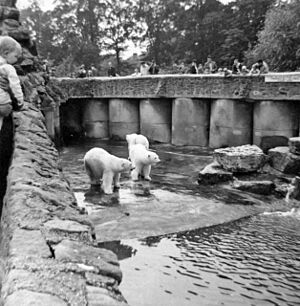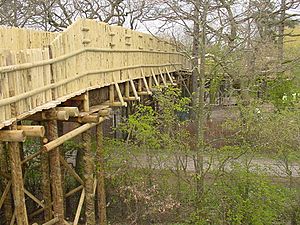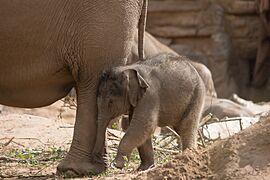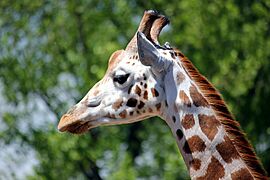Chester Zoo facts for kids
 |
|

The main entrance to Chester Zoo
|
|
| Date opened | 1931 |
|---|---|
| Location | Upton-by-Chester, Cheshire, England |
| Land area | 51 hectares (130 acres) |
| Coordinates | 53°13′36″N 2°53′3″W / 53.22667°N 2.88417°W |
| No. of animals | 35,000+ |
| No. of species | 500+ |
| Annual visitors | 1,971,178 |
| Major exhibits | Monsoon Forest, Islands, Heart of Africa, Mkomazi National Park Painted Dogs Conserve, Elephants of the Asian Forest, Realm of the Red Ape, Tsavo Black Rhino Experience, Spirit of the Jaguar |
| Website | https://www.chesterzoo.org |
Chester Zoo is a famous zoo located in Cheshire, England. It was opened in 1931 by a man named George Mottershead and his family. It is one of the biggest zoos in the United Kingdom, covering a large area of 51 hectares (130 acres).
The zoo is run by a charity and does not get money from the government. It is the most popular wildlife park in Britain, with over 2 million people visiting in 2019. Many people think it's one of the best zoos in the world. In 2024, TripAdvisor named it the best zoo in the UK and the third best in the world.
The Story of Chester Zoo
How it All Began
George Mottershead loved animals from a young age. His family had a plant business, and he would collect interesting creatures like lizards and insects that arrived with the plants. When he was a boy, a trip to a zoo in Manchester inspired him to create his own.
After being injured in World War I, George started collecting more animals. He bought a large house called Oakfield Manor in 1930. The house had big gardens, which were perfect for a zoo. Some local people were not happy about the idea, but George won them over. Chester Zoo officially opened on June 10, 1931.
A Zoo Without Bars
George Mottershead had a special idea for his zoo. He did not want to use old-fashioned iron bars to keep the animals in cages. Instead, he used moats and ditches filled with water to separate the animals from the visitors. This gave the animals more space and made the zoo feel more natural.
For example, in 1956, the zoo created a new home for chimpanzees on grassy islands. A strip of water was the only thing between them and the visitors. At the time, no one knew if chimps could swim. It turned out they couldn't, and the chimp islands became a famous part of the zoo.
After World War II, the zoo grew quickly. George was very clever and used recycled materials to build new homes for the animals. The polar bear exhibit, built in 1950, was made from old roadblocks from the war.
Modern Times at the Zoo
The zoo is always adding new and exciting things. In 2015, a huge new area called Islands at Chester Zoo opened. It lets visitors explore different island habitats from Southeast Asia, like Sumatra and the Philippines.
On December 15, 2018, a fire broke out in the Monsoon Forest habitat due to an electrical problem. The zoo had to close for a day. Sadly, some birds, frogs, and insects were lost in the fire. All the mammals were saved, and the zoo reopened the next day.
In 2024, the zoo welcomed two snow leopards for the first time. They live in a new Himalayan-themed habitat, which is also home to red pandas and special birds.
The Heart of Africa exhibit opened in 2025. This huge area is designed to look like the African grasslands. It features many animals living together, including giraffes, zebras, and thousands of locusts.
Amazing Animal Exhibits
Islands at Chester Zoo
This amazing area lets you feel like you're exploring islands in Southeast Asia. You can walk across bridges or take a boat trip to see the animals. The Islands are home to many rare species that the zoo helps protect.
Animals you can see here include Visayan warty pigs, Sumatran tigers, and the strange-looking North Sulawesi babirusa. There is also a walk-through bird house where beautiful birds like the Bali starling fly freely. The exhibit also features Sumatran orangutans, sun bears, and Malayan tapirs.
Elephants of the Asian Forest
Chester Zoo was the first zoo in the UK to successfully breed Asian elephants. The elephant house is designed to look like a rainforest in Assam, India. Besides elephants, you can also see other Asian animals here. These include colorful birds like the Great hornbill and small mammals like squirrels and tree shrews.
Spirit of the Jaguar
This exhibit is home to the zoo's jaguars. It has both indoor and outdoor areas designed to look like a rainforest and a dry grassland. The jaguars have rivers and pools to swim in. You can also see other South American animals here, like sloths, bush dogs, and a colony of busy leaf-cutter ants.
Realm of the Red Ape

This exhibit is a special home for Bornean orangutans. It has large indoor and outdoor spaces with climbing frames that look like trees. The building is designed to feel like an Indonesian rainforest. It also houses other animals from the region, including lar gibbons, colorful birds, and interesting reptiles like the reticulated python.
The Chimpanzee Breeding Centre
This is home to the largest group of Western chimpanzees in Europe. They live in a large indoor building connected to an outdoor island with lots of space to climb and play.
Tsavo Rhino Experience
This area is modeled after Tsavo National Park in Kenya. It is home to the zoo's black rhinoceroses. The zoo has a very successful breeding program for these endangered animals. Nearby, you can also see meerkats, crested porcupines, and warthogs.
Fruit Bat Forest
This is Europe's largest free-flying bat cave. You can walk through as two types of fruit bats, the Rodrigues fruit bat and Seba's short-tailed bat, fly around you. It's a unique experience to see these amazing creatures up close.
Dragons in Danger
This building is home to the mighty Komodo dragon, the world's largest lizard. The exhibit was the first place outside of their native country where a Komodo dragon laid eggs that hatched without a male. This rare event is called parthenogenesis. The exhibit also features other rare animals from the Philippines and Indonesia.
Helping to Save Wildlife
Chester Zoo does more than just show animals to visitors. It plays a very important role in conservation, which means protecting animals and their homes in the wild.
The zoo is part of many breeding programs for threatened species. This helps to make sure that animals facing extinction do not disappear forever. At the end of 2007, more than half of the animal species at the zoo were on the IUCN Red List of threatened animals.
The zoo manages special breeding programs for animals like the jaguar, eastern black rhinoceros, and Sumatran tiger. In 2015, Chester Zoo became the first zoo outside of New Zealand to successfully breed the tuatara, a rare reptile that has been around since the time of the dinosaurs.
Visiting the Zoo
The zoo is very large, so there are different ways to get around. A path called Flag Lane runs through the middle of the zoo. Two bridges, Elephants' Bridge and Bats' Bridge, connect the two halves.
There are many places to eat, including Bembé Kitchen and The Oakfield, which is a restaurant inside a beautiful old house. There are also play areas for children and plenty of spots for a picnic.
To make it easier to explore, the zoo is divided into colored zones. Each zone has different animals and exhibits. For example, the Yellow Zone has elephants and monkeys, while the Orange Zone is where you'll find the Heart of Africa.
TV Shows About the Zoo
Chester Zoo has been featured in several television shows.
- Zoo Days was a series that showed what happens behind the scenes at the zoo.
- Our Zoo was a BBC drama about how George Mottershead started the zoo.
- The Secret Life of the Zoo is a popular Channel 4 show that follows the lives of the animals and their keepers.
Gallery
-
Mandrill (Mandrillus sphinx).
-
Humboldt penguins (Spheniscus humboldti) with a zookeeper.
-
At the rhinoceros enclosure.
-
Meerkat (Suricata suricatta).

















